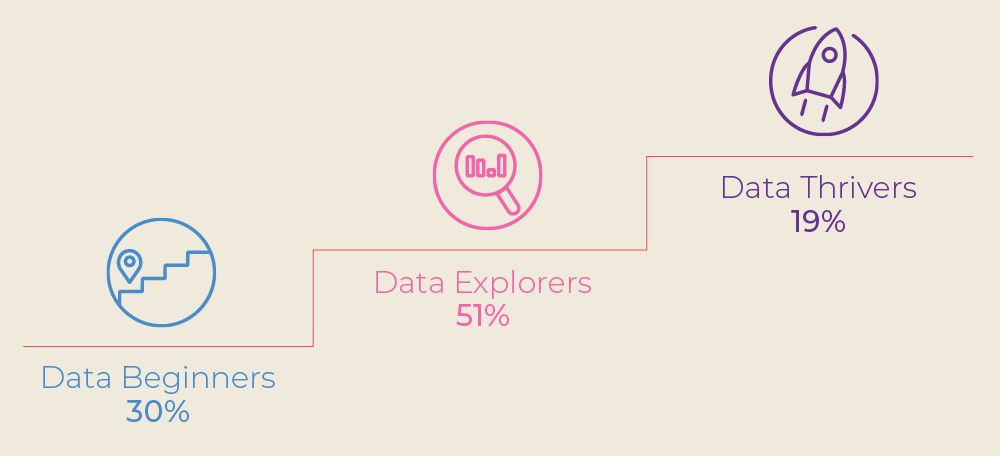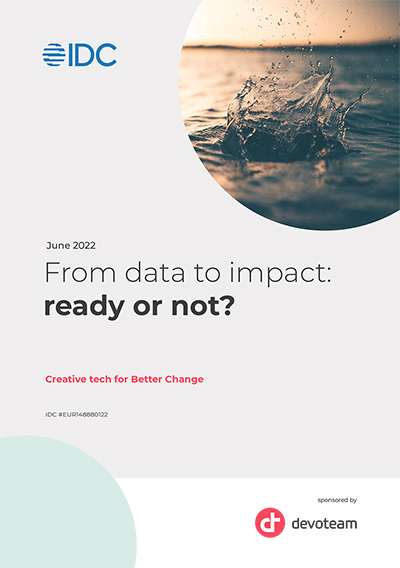Most EMEA businesses are still at the starting point when it comes to being data driven.
How Do We Know?
The data-driven survey was based on IDC’s data-driven maturity framework, categorizing organizations across three levels of maturity:
- Data Beginner — starting level
- Data Explorer — mid level
- Data Thriver — highest level
Only 19% of EMEA organizations demonstrated high levels of maturity and qualify as Data Thrivers or data-first trailblazers.
The organizations are thoroughly assessed across three core dimensions: data strategy, data for business, and data foundation. The framework measures and reveals organizations’ maturity across each of these pillars as well as overall maturity. This helps organizations to understand their strengths and weaknesses and to carry out the actionable advice provided by IDC to succeed as a data-driven business.
The survey revealed that 30% of EMEA organizations are Data Beginners, 51% are Data Explorers, and 19% are Data Thrivers.
IDC Framework: Three Stages of Maturity and Three Dimensions
IDC’s data-driven research explains the three core dimensions — what they are, why they are important, and how they are measured. The three stages of maturity plot organizations in those stages based on their progress across the three dimensions — strategy, business, and foundation.
Let’s delve a bit deeper into the three stages of maturity and the data-driven framework.
The Three Stages of Maturity
There are three stages of maturity in the data-driven journey:

Characteristics of Each Stage of Maturity
Data Beginners — 30% of EMEA Organizations
Data Beginners are at the beginning of their data-driven journey. They have some use cases and business decisions driven by existing analytics tools such as batch analytics and traditional Big Data platforms. The business users or data science teams have limited trust in the insights and quality of data. Their data strategies are isolated and heavily driven by IT teams with limited input from business stakeholders. Many of the key data-enabling tools — data management, visualization, analytics — are not ready to accommodate the data volume, variety, or velocity of the digital age.
Data Explorers — 51% of EMEA Organizations
Data Explorers are well underway on their data journey and use data on a wider scale than Data Beginners and actively use insights to drive business outcomes and adaptability to uncertainties. They are aware of the barriers and bottlenecks when it comes to scaling their data strategies and linking them with business outcomes. Data programs, however, are still ad hoc, driven inconsistently and mostly IT led rather than business led. There is inconsistency in data technology architecture where some dimensions such as data visualization are more mature, but there are gaps in data management strategies and limited focus from all stakeholders. These organizations are not yet ready to monetize data or actively use it for innovation of new products and services. The inconsistency is also holding them back from exploring next-gen data enablers, such as AI and ML, at scale.
Data Thrivers — 19% of EMEA Organizations
Data Thrivers take a holistic approach to becoming data driven and have equal representation from IT, data science, and business teams. They allocate a higher portion of IT budgets to data-driven strategies. 72% of Data Thrivers invest more than 25% of their IT budgets for data, compared with just 33% of Data Beginners. Thrivers are continuously evolving their data infrastructure and continuously adapting their skills and processes and training new staff to maintain their momentum as Data Thrivers. They are also more hands-on in continuously strengthening their data operations, governance, and processes to improve the quality and value of data across the organization. Many are focusing on improving data visualization capabilities to deliver “quick answers” to accelerate time to market.
Act Now: The Widening Gap Between Leaders and Laggards Underlines the Urgency to Become Data Driven
Data Thrivers are far ahead of their peers in embracing innovation accelerators such as AI and ML, and in exploring how to launch data products and services, leverage external data sources, and set revenue targets for data projects. Data Thrivers have outperformed less mature organizations in key business indicators such as revenue, customer satisfaction, operational efficiency, speed to market, and cost efficiency.
Data Thrivers clearly adapt better than their less mature peers to the changes brought by the COVID-19 pandemic (see Figure 1).
Figure 1
Business Impact and Value of Being Data Driven
Q. How prepared was your organization to address the following requirements brought on by COVID-19 in 2020?
Data Thrivers are also able to develop significant competitive advantage compared to their less mature peers (see Figure 2).
Figure 2
Data-Driven Approaches Proved Valuable for Pandemic Recovery
Q. How did your organization perform over the past 12 months on each of the following indicators?
Organizations that are serious about their digital future need to take action to close the gap.
Why are Data Thrivers so far ahead? They have a solid foundation built on insights and digital technologies to better execute on new capabilities such as AI- and ML-driven products and services, automation across data life-cycle management, and empowering data and business users with better visualization tools. They can also rapidly evolve a top-down data-driven culture and upskill their professionals, and are willing to test modern data architectures such as cloud data lakes, data warehouses, and data mesh architectures. Their long-term road map is also more mature compared with less advanced organizations, with strategies such as operationalizing data governance and compliance, and enabling data self-service.
What Can We Learn From Data Thrivers?
Success begets more success. Data Thrivers can move much faster and even attract and retain strong data-focused talent.
The digital future is not viable if organizations can’t become data driven. IDC predicts that by 2023, 60% of enterprise intelligence initiatives will be business specific, purpose built for business, shortening the data to decision time by 30% and driving higher agility and resilience.
The Clock Is Ticking: Time to Make Some Fundamental Changes to Become Successfully Data Driven
- Progress across the three dimensions needs to be aligned. An organization cannot become fully data driven by enhancing or mastering just one or two of the three dimensions. They are all co-dependent and require a balanced approach around technology, people, process, and stakeholder transformation.
- Start with a solid data strategy with a top-down approach, enterprisewide alignment of data-first culture, frequent datathons, skills upgrades, and clearly defined data ownership to get maximum value from data. Then develop strong business links and prioritize data projects to meet business objectives. Data-driven success depends on defining clear business outcomes with data and delivering on them as demonstrated by Data Thrivers in Figures 1 and 2 above.
- Turn the data strategy and clearly defined business objectives into reality by using the right data technology foundation built on modern pillars such as cloud platforms, cloud data lakes, cloud storage, query tools, modern databases, new visualization tools, and managed services where necessary. For about 6 in 10 EMEA organizations, data-driven strategies and initiatives are still led by IT and not by business. This must change and business needs to play an active role.
Finally, prepare for a paradigm shift — the future is different. The survey highlighted how newer data types, the need for real-time analytics, and higher governance requirements are becoming more important in data-driven strategies (see Figure 3).
Figure 3
Newer Data Types on the Horizon in 2022 and Beyond: What Data Type Is Key Today and in the Future
Other considerations such as digital sovereignty and use of sovereign clouds are also becoming more prominent. Becoming data driven is only part of the story. Staying data driven is equally important and continuously evaluating progress in the three pillars is essential to keep on top of the game.
The data-driven future is bright for organizations that “get” this and make it a core priority for their digital future.
Not all organizations have the same maturity when it comes to creating business value with data.
